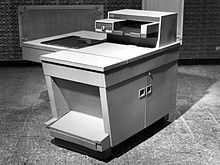Xerox 914

The Xerox 914 was the first successful commercial plain paper copier which in 1959 revolutionized the document-copying industry. The culmination of inventor Chester Carlson's work on the xerographic process, the 914 was fast and economical. The copier was introduced to the public on September 16, 1959, in a demonstration at the Sherry-Netherland Hotel in New York, shown on live television.[1]
One of the most successful Xerox products ever, a 914 model could make 100,000 copies per month (one copy every 26.4 seconds, or ~136 copies/hour). In 1985, the Smithsonian received a Xerox 914, number 517 off the assembly line. It weighs 648 pounds (294 kg) and measures 42" (107 cm) high × 46" (117 cm) wide × 45" (114 cm) deep.
The Xerox 914 was so named because it could copy originals up to 9 inches by 14 inches (229 mm × 356 mm). The company's subsequent models were the 720, the 1000, the 813 and the 2400.
A floor-mounted device, the external design was created by James G. Balmer of Armstrong-Balmer & Associates, in collaboration with engineers Don Shepardson, John Rutkus and Hal Bogdenoff of Xerox, who had developed an engineering prototype.
One disadvantage of the Xerox 914 was that it had a tendency to catch fire when overheated (Ralph Nader claimed that a model in his office had caught fire three times in a four-month period). Because of the problem, the Xerox company provided a "scorch eliminator", which was actually a small fire extinguisher, along with the copier.[1]
Balmer had recently left Harley Earl, Inc., where he had been a designer since 1946, to co-establish Armstrong-Balmer & Associates in 1958. At Earl, Balmer had been involved in the Secretary copy machine designed for Thermofax and introduced by 3M in 1958, and Haloid Xerox had been impressed with the design, engaging Balmer to consult on the final design of the 914.
Xerography, a process of producing images using electricity, was invented in 1938 by physicist-lawyer Chester Floyd "Chet" Carlson (1906–1968), and an engineering friend, Otto Kornei.
Carlson entered into a research agreement with the Battelle Memorial Institute in 1944, when he and Kornei produced the first operable copy machine. He sold his rights in 1947 to the Haloid Company, a wet-chemical photocopy machine manufacturer, founded in 1906 in Rochester, NY.
The first commercial xerographic copier, the Xerox Model A, was introduced in 1949 by Haloid, which had the previous year announced the refined development of xerography in collaboration with Battelle Development Corporation, of Columbus, OH. Manually operated, it was also known as the Ox Box. An improved version, Camera #1, was introduced in 1950.
Haloid had been renamed Haloid Xerox in 1958, and, after the instant success of the 914, when the name Xerox soon became synonymous with "copy", would become the Xerox Corporation.
In 1963, Xerox introduced the first desktop copier to make copies on plain paper, the 813. It was also designed by Jim Balmer and William H. Armstrong of Armstrong-Balmer & Associates, and won a 1964 Certificate of Design Merit from the Industrial Designers Institute (IDI).
A year later, in 1964, Balmer worked with Xerox to establish their first internal industrial design group. Among those first design employees were William Dalton and Robert Van Valkinburgh.
References
- ↑ 1.0 1.1 Hemmungs Wirtén, Eva (2004). No Trespassing: Authorship, Intellectual Property Rights, and the Boundaries of Globalization. University of Toronto Press. p. 61. ISBN 978-0-8020-8608-2.
- Owen, David (2004). Copies in Seconds: Chester Carlson and the Birth of the Xerox Machine. Simon & Schuster. ISBN 978-1-4223-5892-4.
- Tenner, Edward (July–August 2010). "The Mother of All Invention". The Atlantic. Retrieved 2010-06-12.